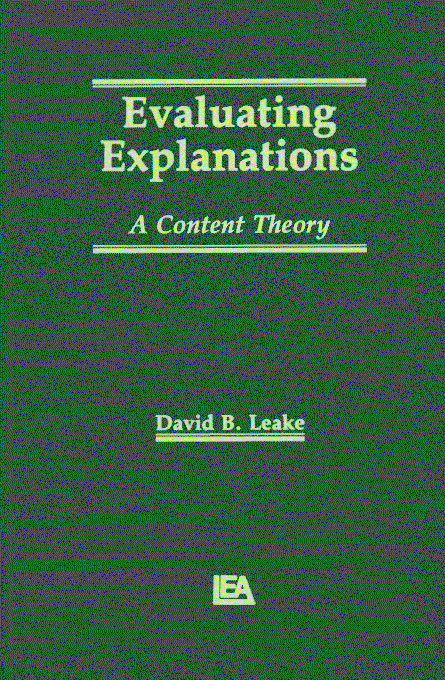
Psychology and philosophy have long studied the nature and role of explanation. More recently, artificial intelligence research has developed promising theories of how explanation facilitates learning and generalization. By using explanations to guide learning, explanation-based methods allow reliable learning in complex situations.
This volume addresses fundamental issues in generating and judging explanations: When to explain, what constitutes an explanation, how to build explanations, and how to evaluate candidate explanations. It examines the problem of everyday explanation of anomalous events, and argues that context---involving explainer goals, beliefs, and experience---is crucial to generating and judging those explanations. The theory developed is not only a theory of the process of explanation, but also of the content of the knowledge required to detect anomalies and guide search for explanations.
The book presents models of pattern-based anomaly detection as a means to automatically generate appropriate target concepts for explanation; of how the search for explanations of anomalies can be focused by case-based reasoning; and of goal-based evaluation of candidate explanations. It describes the implementation of these theories in ACCEPTER, a computer system that understands stories, detects anomalous events, retrieves relevant explanations from memory, and evaluates candidate explanations in light of overarching goals.
ACKNOWLEDGMENTS ix
OVERVIEW AND READER'S GUIDE xi
1. EXPLANATION AND UNDERSTANDING 1
1.1 Fashioning Beliefs 1
1.2 Maintaining Beliefs During Understanding 4
1.3 Routine Understanding 5
1.4 Detecting Anomalies 6
1.5 Learning by Explaining Anomalies 10
1.6 What Is a Good Explanation? 12
1.7 Constructing Explanations 15
1.8 Implementing the Theory 16
1.9 Significance for Explanation-Based Systems 27
1.10 The Following Chapters 29
2. PERSPECTIVE ON THE THEORY 31
2.1 The SWALE Project 32
2.2 ACCEPTER Overview and Sample Run 36
2.3 Comparison to Views from AI 53
2.4 Comparison to Views from Psychology 66
2.5 Comparison to Views from Philosophy 67
2.6 Summary 69
3. ANOMALIES AND ROUTINE UNDERSTANDING 71
3.1 The Nature of Anomalies 71
3.2 ACCEPTER's Routine Understanding 72
3.3 Overview of ACCEPTER's Anomaly Detection 84
3.4 Conflicts with Specific Prior Expectations 84
3.5 The Need for Additional Tests 90
4. PATTERN-BASED ANOMALY DETECTION 91
4.1 Overview of ACCEPTER's Pattern Types 92
4.2 ACCEPTER's Patterns and their Structure 94
4.3 Pattern Retrieval 106
4.4 The Need to Identify Underlying Problems 107
4.5 Finer Grained Checks 109
4.6 What ACCEPTER's Checks Miss 118
4.7 Judging ACCEPTER's Anomaly Detection 121
4.8 Summary 122
5. ANOMALY CHARACTERIZATION 125
5.1 From Detection to Characterization 125
5.2 The Information Characterizations Include 126
5.3 How Characterization Guides Search 128
5.4 Mapping Conflicts to Characterizations 132
5.5 Defining the Content of Anomaly Categories 135
6. A VOCABULARY FOR ANOMALIES 137
6.1 Overview of the Categories 138
6.2 SURPRISING-PLAN-CHOICE 143
6.3 SURPRISING-PROP-CHOICE 150
6.4 Conclusion 152
7. NONMOTIVATIONAL ANOMALY TYPES 155
7.1 Overview of Nonmotivational Anomalies 155
7.2 PLAN-EXECUTION-FAILURE 156
7.3 BLOCKAGE-VIOLATION 162
7.4 PROCESS-EXECUTION-FAILURE 164
7.5 DEVICE-FAILURE 166
7.6 INFORMATION-FAILURE 167
7.7 UNUSUAL-FEATURE 168
7.8 FEATURE-DURATION-FAILURE 169
7.9 Judging the Vocabulary 170
7.10 Conclusion 171
8. EVALUATING RELEVANCE AND PLAUSIBILITY 175
8.1 Accounting for Surprising Features 176
8.2 Accounting for Why Expectations Failed 182
8.3 Evaluating Plausibility 187
8.4 Conclusion 195
9. FOCUSING ON IMPORTANT FACTORS 197
9.1 Each Anomaly Has Many Explanations 197
9.2 How Goals Affect Explanation 198
9.3 Major Explanation Purposes 201
9.4 How Explanation Purposes Arise 202
9.5 How Goals Affect ACCEPTER's Evaluation 205
9.6 Explaining to Predict 206
9.7 Explaining for Repair 216
9.8 Explaining for Control 220
9.9 Explaining to Assign Praise or Blame 226
9.10 Sketch of Requirements for Other Goals 228
9.11 Summary of Evaluation Dimensions 230
9.12 Goal-Based Adaptation 232
9.13 Conclusion 232
10. CONCLUSIONS AND FUTURE DIRECTIONS 235
10.1 Summary and Significance of the Theory 235
10.2 Future Directions 237
10.3 Final Notes 241
REFERENCES 243
AUTHOR INDEX 255
SUBJECT INDEX 257